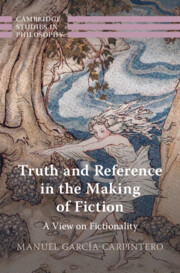Refine search
Actions for selected content:
142 results

Truth and Reference in the Making of Fiction
- A View on Fictionality
-
- Published online:
- 18 December 2025
- Print publication:
- 22 January 2026
Chapter 4 - Rumstick Road in Rehearsal
-
- Book:
- American Performance in 1976
- Published online:
- 27 November 2025
- Print publication:
- 11 December 2025, pp 215-268
-
- Chapter
- Export citation
Introduction
-
- Book:
- American Performance in 1976
- Published online:
- 27 November 2025
- Print publication:
- 11 December 2025, pp 1-43
-
- Chapter
- Export citation
Chapter 3 - Einstein on the Beach
-
- Book:
- American Performance in 1976
- Published online:
- 27 November 2025
- Print publication:
- 11 December 2025, pp 156-214
-
- Chapter
- Export citation
Chapter 2 - Quarry
-
- Book:
- American Performance in 1976
- Published online:
- 27 November 2025
- Print publication:
- 11 December 2025, pp 104-155
-
- Chapter
- Export citation
Saving Katoku: A Case Study of the Conflicting Environmental and Economic Demands on Japan’s Island Communities – CORRIGENDUM
-
- Journal:
- Asia-Pacific Journal / Volume 23 / 2025
- Published online by Cambridge University Press:
- 28 November 2025, e23
-
- Article
-
- You have access
- Open access
- HTML
- Export citation
Class, Relationships, and the Art of Historical Imagination: An Oral History Interview with Daniel James
-
- Journal:
- The Americas , First View
- Published online by Cambridge University Press:
- 26 November 2025, pp. 1-28
-
- Article
- Export citation
Chapter 3 - Island Periploi
-
- Book:
- American Modernism and the Cartographic Imagination
- Published online:
- 09 October 2025
- Print publication:
- 23 October 2025, pp 111-147
-
- Chapter
- Export citation
5 - Sculpture, Relief, and the Surrounding Space
-
-
- Book:
- Relief in Greek, Roman, and Late Antique Art
- Published online:
- 11 October 2025
- Print publication:
- 25 September 2025, pp 166-198
-
- Chapter
- Export citation
The ‘brutal force’ of the mines: natural resources and the aesthetic of extraction in Fascist Italy
-
- Journal:
- Modern Italy , First View
- Published online by Cambridge University Press:
- 08 September 2025, pp. 1-26
-
- Article
-
- You have access
- Open access
- HTML
- Export citation
Chapter 2 - A Personal Style of Face
-
- Book:
- Face and Form
- Published online:
- 21 August 2025
- Print publication:
- 04 September 2025, pp 43-64
-
- Chapter
-
- You have access
- Open access
- HTML
- Export citation
“Is This Picture Not a Proof?”: Photojournalism and Anti-Colonial Politics in Lagos, 1930s–1950s
-
- Journal:
- African Studies Review / Volume 68 / Issue 2 / June 2025
- Published online by Cambridge University Press:
- 15 August 2025, pp. 227-251
-
- Article
- Export citation
Chapter 8 - Learning in visual arts
- from Part 2 - What: the arts learning areas
-
- Book:
- Teaching the Arts
- Published online:
- 28 July 2025
- Print publication:
- 06 August 2025, pp 235-278
-
- Chapter
- Export citation
To measure the straight distance, by travelling the winding way
- Part of
-
- Journal:
- Memory, Mind & Media / Volume 4 / 2025
- Published online by Cambridge University Press:
- 29 July 2025, e7
-
- Article
-
- You have access
- Open access
- HTML
- Export citation
Saving Katoku: A Case Study of the Conflicting Environmental and Economic Demands on Japan’s Island Communities
-
- Journal:
- Asia-Pacific Journal / Volume 23 / 2025
- Published online by Cambridge University Press:
- 25 July 2025, e11
-
- Article
-
- You have access
- Open access
- HTML
- Export citation
The Muslim world as heterotopia: Global encounters in interwar Europe
-
- Journal:
- Journal of Global History , First View
- Published online by Cambridge University Press:
- 18 July 2025, pp. 1-26
-
- Article
-
- You have access
- Open access
- HTML
- Export citation
9 - The First Departure
-
- Book:
- A Black Army
- Published online:
- 16 June 2025
- Print publication:
- 17 July 2025, pp 169-185
-
- Chapter
- Export citation
Chapter 1 - Drift
-
- Book:
- Embodiment in Nineteenth-Century American Literature
- Published online:
- 29 June 2025
- Print publication:
- 17 July 2025, pp 26-54
-
- Chapter
- Export citation
10 - Cultural Activity in the Holocaust
-
-
- Book:
- The Cambridge History of the Holocaust
- Published online:
- 16 May 2025
- Print publication:
- 12 June 2025, pp 163-184
-
- Chapter
- Export citation
Hiding in plain sight: visual histories in Greece
-
- Journal:
- Byzantine and Modern Greek Studies / Volume 49 / Issue 1 / April 2025
- Published online by Cambridge University Press:
- 27 March 2025, pp. 78-87
- Print publication:
- April 2025
-
- Article
- Export citation
